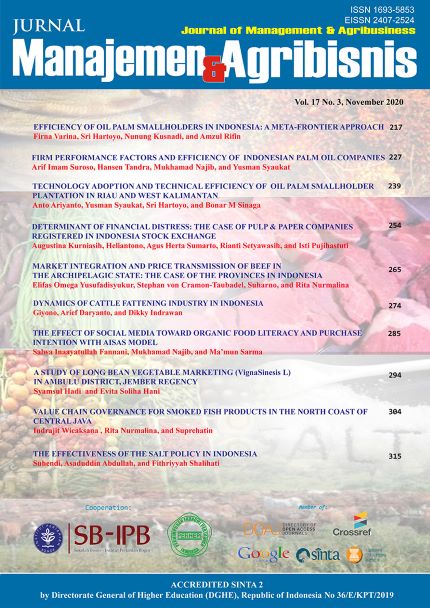Abstract
The cattle fattening industry faces challenges from external factors, especially macroeconomic conditions and industry challenges with the increasing beef substitution imports to replace fresh beef. This research aimed to analyze the dynamics of cattle fattening industry in Indonesia. Porter's Five Forces analysis was conducted to see the mapping of competitions in the cattle fattening industry. PESTEL analysis was conducted to see external factors that affected live cattle imports in Indonesia. Cointegration and Error Correction Model analysis was conducted to see important and influencing factors of live cattle imports in Indonesia as the dependent variables and exchange rates, Gross Domestic Product, beef imports, beef offal imports and buffalo meat imports as the independent variables. This research used time series data based on the 2011-2019 data obtained from the Central Statistics Agency, the Ministry of Agriculture and Bank Indonesia. The results of Porter's Five Forces analysis showed high competition in the cattle fattening industry with the threat of substitute products, which was the factor that fully needed a response with the right strategy by the cattle fattening industry. The results of PESTEL analysis showed that external factors had a high effect on the cattle fattening industry, with the most important things that needed to be considered based on conditions, influences on the industry and level of importance including the factors of the development of animal feed technology, exchange rate fluctuation and national economic growth. The results of the Cointegration and Error Correction Model analysis showed that the factors that were important and affected live cattle imports in Indonesia included exchange rates, beef imports and buffalo meat imports.
Keywords: beef, buffalo meat, error correction model, exchange rate, live cattle
Authors
Authors who publish with this journal agree to the following terms:
- Authors retain copyright and grant the journal right of first publication with the work simultaneously licensed under a Creative Commons Attribution License that allows others to share the work with an acknowledgement of the work's authorship and initial publication in this journal.
- Authors are able to enter into separate, additional contractual arrangements for the non-exclusive distribution of the journal's published version of the work (e.g., post it to an institutional repository or publish it in a book), with an acknowledgement of its initial publication in this journal.
- Authors are permitted and encouraged to post their work online (e.g., in institutional repositories or on their website) prior to and during the submission process, as it can lead to productive exchanges, as well as earlier and greater citation of published work (See The Effect of Open Access).

